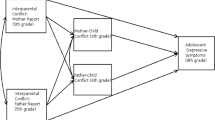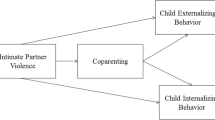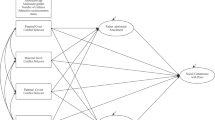Abstract
Research demonstrates significant associations between coparenting conflict and child adjustment problems. However, the implications of youth adjustment for coparenting, especially during youth’s adolescence, remain poorly understood. Addressing several gaps in the literature, this study examines the longitudinal trajectory of mothers’ and fathers’ reported coparenting conflict from youth ages 10–17 and tests bidirectional associations between youth social anxiety, hostility, risk-taking behaviors, and mothers’ and fathers’ coparenting conflict. Participants include 757 mothers, fathers, and youth in two-parent families (M youth age = 11.28, SD = 0.49; 53% female) who participated in 5 waves of data collection when youth were in the 6th to 9th grades. Multilevel growth curve models revealed significant non-linear change in mothers’ and fathers’ coparenting conflict, such that coparenting conflict declined through youth’s transition to adolescence, leveled off in early adolescence, and declined in the mid-late adolescent years. Cross-lagged models showed significant positive associations between youth social anxiety and hostility and coparenting conflict at the following time point, but coparenting conflict did not predict later youth adjustment problems in these domains. There were significant bidirectional associations between mother-reported coparenting conflict and youth risk-taking behaviors; the associations between coparenting conflict and risk-taking were not significant for fathers. The findings demonstrate that investigating longitudinal associations between youth adjustment and coparenting conflict may provide new insights into the role of child effects for mothers’ and fathers’ coparenting experiences.




Similar content being viewed by others
References
Anderson, L. S. (2008). Predictors of parenting stress in a diverse sample of parents of early adolescents in high-risk communities. Nursing Research, 57, 340.
Baril, M. E., Crouter, A. C., & McHale, S. M. (2007). Processes linking adolescent well-being, marital love, and coparenting. Journal of Family Psychology, 21(4), 645–654.
Bell, R. Q. (1968). A reinterpretation of the direction of effects in studies of socialization. Psychological Review, 75(2), 81–95.
Bentler, P. M. (1990). Comparative fit indexes in structural models. Psychological Bulletin, 107, 238–246.
Brown, G. L., Schoppe-Sullivan, S. J., Mangelsdorf, S. C., & Neff, C. (2010). Observed and reported supportive coparenting as predictors of infant–mother and infant–father attachment security. Early Child Development and Care, 180, 121–137.
Buss, A. H., & Durkee, A. (1957). An inventory for assessing different kinds of hostility. Journal of Consulting Psychology, 21, 343–349.
Clauss, J. A., & Blackford, J. U. (2012). Behavioral inhibition and risk for developing social anxiety disorder: a meta-analytic study. Journal of the American Academy of Child & Adolescent Psychiatry, 51, 1066–1075.
Conger, R. D. (1989). Iowa youth and families project, Wave A. Report prepared for Iowa State University. Ames, IA: Institute for Social and Behavioral Research.
Cox, M. J., & Paley, B. (2003). Understanding families as systems. Current Directions in Psychological Science, 12, 193–196.
Crouter, A. C., & Head, M. R. (2002). Parental monitoring and knowledge of children. In M. H. Bornstein (Ed.), Handbook of parenting: Being and becoming a parent (pp. 461–483). Mahwah, NJ: Lawrence Erlbaum Associates Publishers.
Cui, M., Donnellan, M. B., & Conger, R. D. (2007). Reciprocal influences between parents' marital problems and adolescent internalizing and externalizing behavior. Developmental Psychology, 43, 1544–1552.
Davies, P. T., Sturge-Apple, M. L., Woitach, M. J., & Cummings, E. M. (2009). A process analysis of the transmission of distress from interparental conflict to parenting: adult relationship security as an explanatory mechanism. Developmental Psychology, 45, 1761–1773.
Elliott, D. (1985). National Youth Survey: Wave I, 1976. Ann Arbor, MI: Inter-university Consortium for Political and Social Research.
Enders, C. K., & Bandalos, D. L. (2001). The relative performance of full information maximum likelihood estimation for missing data in structural equation models. Structural Equation Modeling, 8, 430–457.
Fagot, B. I., Kronsberg, S., & MacGregor, D. (1985). Adult responses to young children in risky situations. Merrill-Palmer Quarterly, 31, 385–395.
Feinberg, M. E. (2003). The internal structure and ecological context of coparenting: a framework for research and intervention. Parenting: Science and Practice, 3, 95–131.
Feinberg, M. E., Brown, L. D., & Kan, M. L. (2012). A multi-domain self-report measure of coparenting. Parenting, 12, 1–21.
Feinberg, M. E., Kan, M. L., & Hetherington, E. M. (2007). The longitudinal influence of coparenting conflict on parental negativity and adolescent maladjustment. Journal of Marriage and Family, 69, 687–702.
Harold, G. T., Shelton, K. H., Goeke-Morey, M. C., & Cummings, E. M. (2004). Marital conflict, child emotional security about family relationships, and child adjustment. Social Development, 13, 350–376.
Jenkins, J., Simpson, A., Dunn, J., Rasbash, J., & O'Connor, T. G. (2005). Mutual influence of marital conflict and children’s behavior problems: Shared and nonshared family risks. Child Development, 76, 24–39.
Jones, D. J., Shaffer, A., Forehand, R., Brody, G., & Armistead, L. P. (2003). Coparent conflict in single mother-headed African American families: do parenting skills serve as a mediator or moderator of child psychosocial adjustment? Behavior Therapy, 34, 259–272.
Kearney, M. W. (2017). Cross-lagged panel analysis. In M. Allen (Ed.), SAGE encyclopedia of communication research methods (pp. 313–314). Thousand Oaks, CA: SAGE.
Kline, R. B. (2005). Principles and practice of structural equation modeling. New York, NY: Guilford.
LaGreca, A. M., & Lopez, N. (1998). Social anxiety among adolescents: Linkages with peer relations and friendships. Journal of Abnormal Child Psychology, 26, 83–94.
Lindsey, E. W., Caldera, Y., & Colwell, M. (2005). Correlates of coparenting during infancy. Family Relations, 54, 346–359.
Littlefield, A. K., Stevens, A. K., Ellingson, J. M., King, K. M., & Jackson, K. M. (2016). Changes in negative urgency, positive urgency, and sensation seeking across adolescence. Personality and Individual Differences, 90, 332–337.
Lubenko, J., & Sebre, S. (2010). Longitudinal associations between adolescent behaviour problems and perceived family relationships. Procedia-Social and Behavioral Sciences, 5, 785–790.
Majdandžić, M., de Vente, W., Feinberg, M. E., Aktar, E., & Bögels, S. M. (2012). Bidirectional associations between coparenting relations and family member anxiety: A review and conceptual model. Clinical Child and Family Psychology Review, 15, 28–42.
Marceau, K., Zahn-Waxler, C., Shirtcliff, E. A., Schreiber, J. E., Hastings, P., & Klimes-Dougan, B. (2015). Adolescents’, mothers’, and fathers’ gendered coping strategies during conflict: youth and parent influences on conflict resolution and psychopathology. Development and Psychopathology, 27, 1025–1044.
Margolin, G., Gordis, E. B., & John, R. S. (2001). Coparenting: a link between marital conflict and parenting in two-parent families. Journal of Family Psychology, 15, 3–21.
McHale, J. P. (1995). Coparenting and triadic interactions during infancy: the roles of marital distress and child gender. Developmental Psychology, 31, 985–996.
MacCallum, R. C., Browne, M. W., & Sugawara, H. M. (1996). Power analysis and determination of sample size for covariance structure modeling. Psychological Methods, 1, 130–149.
McMahon, R. J., & Metzler, C. W. (1998). Selecting parenting measures for assessing family-based prevention interventions. In R. S. Ashery, E. B. Robertson, & K. L. Kumpfer (Eds.), Drug abuse prevention through family interventions, (NIDA Research Monograph No. 177, pp. 294–323). Rockville, MD: National Institute on Drug Abuse.
Parke, R. D. (2002). Fathers and families. In M. H. Bornstein (Ed.), Handbook of parenting: Being and becoming a parent (pp. 27–73). Mahwah, NJ: Lawrence Erlbaum Associates Publishers.
Raudenbush, S. W., & Bryk, A. S. (2002). Hierarchical linear models: Applications and data analysis methods (Vol. 1). Thousand Oaks, CA: Sage.
Riina, E. M., & Feinberg, M. E. (2018). The trajectory of coparenting relationship quality across early adolescence: family, community, and parent gender influences. Journal of Family Psychology, 32, 599–609.
Riina, E. M., & McHale, S. M. (2012). The trajectory of coparenting satisfaction in African American families: the impact of sociocultural stressors and supports. Journal of Family Psychology, 26, 896–905.
Riina, E. M., & McHale, S. M. (2014). Bidirectional influences between dimensions of coparenting and adolescent adjustment. Journal of Youth and Adolescence, 43, 257–269.
Selig, J. P., & Little, T. D. (2012). Autoregressive and cross-lagged panel analysis for longitudinal data. In B. Laursen & T. D. Little (Eds.), Handbook of developmental research methods (pp. 265–278). New York, NY: Guilford.
Serbin, L. A., Kingdon, D., Ruttle, P. L., & Stack, D. M. (2015). The impact of children’s internalizing and externalizing problems on parenting: transactional processes and reciprocal change over time. Development and Psychopathology, 27, 969–986.
Smetana, J., Crean, H. F., & Campione-Barr, N. (2005). Adolescents’ and parents’ changing conceptions of parental authority. New Directions for Child and Adolescent Development, 2005, 31–46.
Solmeyer, A. R., & Feinberg, M. E. (2011). Mother and father adjustment during early parenthood: the roles of infant temperament and coparenting relationship quality. Infant Behavior and Development, 34, 504–514.
Spoth, R., Greenberg, M., Bierman, K., & Redmond, C. (2004). PROSPER community–university partnership model for public education systems: capacity-building for evidence-based, competence-building prevention. Prevention Science, 5, 31–39.
Spoth, R., Redmond, C., & Shin (1998). Direct and indirect latent-variable parenting outcomes of two universal family-focused preventive interventions: extending a public health-oriented research base. Journal of Consulting and Clinical Psychology, 66, 385.
Steiger, J. H. (1990). Structural model evaluation and modification: An interval estimation approach. Multivariate Behavioral Research, 25, 173–180.
Steinberg, L., & Silk, J. S. (2002). Parenting adolescents. In M. H. Bornstein (Ed.), Handbook of parenting: Children and parenting (pp. 103–133). Mahwah, NJ: Lawrence Erlbaum Associates Publishers.
Teubert, D., & Pinquart, M. (2010). The association between coparenting and child adjustment: a meta-analysis. Parenting: Science and Practice, 10, 286–307.
Van Egeren, L. A. (2004). The development of the coparenting relationship over the transition to parenthood. Infant Mental Health Journal: Official Publication of the World Association for Infant Mental Health, 25, 453–477.
Yavorsky, J. E., Kamp Dush, C. M., & Schoppe-Sullivan, S. J. (2015). The production of inequality: the gender division of labor across the transition to parenthood. Journal of Marriage and Family, 77, 662–679.
Zemp, M., Johnson, M. D., & Bodenmann, G. (2018). Within-family processes: interparental and coparenting conflict and child adjustment. Journal of Family Psychology, 32, 299–309.
Author information
Authors and Affiliations
Contributions
E.R. conceived of the study, participated in its design and coordination and drafted the manuscript; J.L. participated in statistical analysis and interpretation of the data; M.F. was co-PI on the original grant, participated in the design of the study and helped to interpret data and draft the manuscript. All authors read and approved the final manuscript.
Funding
This research was supported by grants DA 013709 from the National Institute on Drug Abuse, and from the Research Foundation of the City University of New York, 67286-00 45.
Data Sharing and Declaration
Data from this manuscript is not available.
Corresponding author
Ethics declarations
Conflict of Interest
The authors declare that they have no conflict of interest.
Ethical Approval
All procedures described in the study were approved by the local IRB(s).
Informed Consent
All parent and youth study participants were provided with informed consent about the study as part of recruitment procedures.
Additional information
Publisher’s note Springer Nature remains neutral with regard to jurisdictional claims in published maps and institutional affiliations.
Rights and permissions
About this article
Cite this article
Riina, E.M., Lee, Jk. & Feinberg, M.E. Bidirectional Associations between Youth Adjustment and Mothers’ and Fathers’ Coparenting Conflict. J Youth Adolescence 49, 1617–1630 (2020). https://doi.org/10.1007/s10964-020-01262-6
Received:
Accepted:
Published:
Issue Date:
DOI: https://doi.org/10.1007/s10964-020-01262-6




